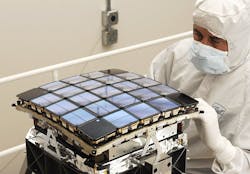Ball Aerospace to help determine how well radiation-hardened electro-optical space sensors perform in orbit
KIRTLAND AIR FORCE BASE, N.M. – U.S. Air Force satellite imaging experts needed a company to help determine how well space sensors such as infrared and visible-light focal plane arrays (FPAs) perform in the radiation environment of space. They found their solution from Ball Aerospace & Technologies Corp. in Beavercreek, Ohio.
Officials of the Air Force Research Laboratory Space Vehicles Directorate at Kirtland Air Force Base, N.M., announced a $7.7 million contract to Ball Aerospace on Thursday for the Infrared Radiation Effects Laboratory (IRREL) operation and improvements program.
Among the biggest jobs of this contract is for Ball Aerospace Experts to help Air Force and industry spacecraft designers understand how well new electro-optical FPAs can withstand naturally occurring radiation in different space orbits.
FPAs essentially are the retinas of satellite-based infrared imaging sensors for military reconnaissance and surveillance, as well as for civil remote sensing to monitor aspects of agriculture, urban development, oil and gas, and utilities.
Related: NASA taps Teledyne for space-qualified electro-optical sensor for WFIRST space telescope
Ball Aerospace experts will help the Air Force understand how well and how long FPAs can operate in space, the level of radiation shielding necessary to extend the sensors' useful lives in space, and ways to design future FPAs that are inherently radiation tolerant.
Ball Aerospace engineers will provide radiometric and radiation characterizations of radiation-hardened infrared and visible-light and related devices. The effort includes developing techniques to improve characterization of infrared and visible-light FPAs and related devices.
Work will include developing analytical techniques, test hardware, and test procedures that improve the IRREL's experimental capabilities.
The IRREL is foremost authority on the evaluation of space-based imaging sensors, Air Force officials say. The lab’s adaptable equipment can characterize sensors for a variety of missions ranging from visible through long-wavelength infrared detection.
Related: Radiation-hardened space electronics enter the multi-core era
The lab enables researchers to conduct tests at radiation sites around the country to address the performance of FPAs in the harsh radiation environment of space and through potential manmade threats such as nuclear explosions.
IRREL provides flight qualification in benign and high-radiation environments for all Air Force, Missile Defense Agency, NASA, and intelligence community satellites.
IRREL investigates fundamental detector materials and architectures of optical sensors to help guide investment and research in visible and infrared focal planes.
On this contract Ball Aerospace will do the work in Albuquerque, N.M., and should be finished by October 2025. For more information contact Ball Aerospace online at www.ball.com/aerospace, or the Space Vehicles Directorate of the Air Force Research Laboratory at www.kirtland.af.mil/Portals/52/documents/RV-Factsheet.pdf?.
About the Author
John Keller
Editor-in-Chief
John Keller is the Editor-in-Chief, Military & Aerospace Electronics Magazine--provides extensive coverage and analysis of enabling electronics and optoelectronic technologies in military, space and commercial aviation applications. John has been a member of the Military & Aerospace Electronics staff since 1989 and chief editor since 1995.

